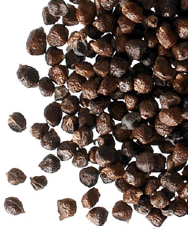Grains of Paradise
- a very special ingredient used in the brewing of Silverback Pale Ale.
 (Excepted from: www.grainsofparadise.com) (Excepted from: www.grainsofparadise.com)
This intriguing spice, often described as a vibrant blend of ginger, cardamom, and pepper, seems to be just as valuable in the medicine cabinet as it is in the spice rack. And although its arrival in the United States is a new chapter in the long, rich history of its story, the spice has made its way into many traditional dishes that are the mainstay of several global cuisines.
Native to the marshy coastal area of the Gulf of Guinea off Western Africa, this little-known member of the ginger family (Zingiberaceae) goes by a number of intriguing names. Botanically, it is the Aframomum meleguetta but is known by other names to many people. The indigenous Obro tribesmen have long known the meleguetta pepper as yoruba; the Chitta call it hausa.
 Other local names include wisa, formwisa, efom wisa, and apokuo. Its peppery personality and native environment are undoubtedly responsible for its identification as Guinea pepper and alligator pepper. In its native habitat, the meleguetta pepper is one of the exotic spices used in the traditional recipes of the peoples of the Grain Coast, stretching from Sierra Leone to Nigeria. Trade routes spanning the vast African desert during the 13th century led to the introduction of this unforgettable flavor to Italy and, soon thereafter, to the rest of the European continent. Other local names include wisa, formwisa, efom wisa, and apokuo. Its peppery personality and native environment are undoubtedly responsible for its identification as Guinea pepper and alligator pepper. In its native habitat, the meleguetta pepper is one of the exotic spices used in the traditional recipes of the peoples of the Grain Coast, stretching from Sierra Leone to Nigeria. Trade routes spanning the vast African desert during the 13th century led to the introduction of this unforgettable flavor to Italy and, soon thereafter, to the rest of the European continent.
From Wikipedia, the free encyclopedia
(Link to Wikipedia article: GOP)
Aframomum melegueta is a species in the ginger family, Zingiberaceae. This spice commonly known as Grains of paradise, Melegueta pepper, alligator pepper, Guinea grains or Guinea pepper is obtained from the plant's ground seeds; it gives a pungent, peppery flavour. Although it is native to West Africa, it is an important cash crop in the Basketo special woreda of southern Ethiopia.
A. melegueta is a herbaceous perennial plant native to swampy habitats along the West African coast. Its trumpet-shaped, purple flowers develop into 5 to 7 cm long pods containing numerous small, reddish-brown seeds. The pungent, peppery taste of the seeds is caused by aromatic ketones. Essential oils, which are the dominating flavor components in the closely related cardamom, occur only in traces.
Grains of Paradise are commonly employed in the cuisines of West Africa and of North Africa, where they have been traditionally imported via caravan routes in a series of transshipments through the Sahara desert and whence they were distributed to Sicily and Italy. Mentioned by Pliny as "African pepper" but subsequently forgotten in Europe, grains of paradise became a very fashionable substitute for black pepper in 14th- and 15th-century[3] Europe, especially in northern France, one of the most populous regions in Europe at the time.
|
|
Grains of Paradise - BioScience Magazine
Out of Africa: A Tale of Gorillas, Heart Disease... and a Swamp Plant
STORY BY CHERYL LYN DYBAS • PHOTOGRAPHY BY ILYA RASKIN
May 2007 / Vol. 57 No. 5 • BioScience 397 • www.biosciencemag.org
Link to Full PDF: GOP-GorillasHeart.pdf
Captive western lowland gorillas (Gorilla gorilla gorilla) are susceptible to a heart condition known as fibrosing cardiomyopathy. Although the cause of the disease is unknown, the captive gorillas’ diet may be a contributing factor. Aframomum melegueta, an herbaceous perennial plant that gorillas in the wild consume with gusto, contains substances with powerful anti-inflammatory properties that may protect gorillas’ health.
______
Biochemists at Rutgers University have found a powerful anti-inflammatory compound in the seeds of the African wetland plant Aframomum melegueta, or grains of paradise. This may be the most powerful anti- inflammatory compound yet discovered. Western lowland gorillas in the wild preferentially eat Aframomum, which makes up 80 to 90 percent of their diet and may be protecting them against heart disease and other illnesses.

______
The plant: Grains of Paradise
Western lowland gorillas in Africa don’t have far to look for A. melegueta. An herbaceous perennial plant, it is among the most common plants in the swampy lowlands there. Palmlike, it forms dense tangles and grows up to 1.5 meters high. Its trumpet-shaped, purple flowers develop into pods filled with small, reddish-brown seeds. The common name for the plant, grains of paradise, comes from its seeds and dates back to the Middle Ages, when the plant was a highly valued commodity. It still is vital to gorillas, who not only eat the plant but use it to make the nests, or beds, where they sleep each night.

|



